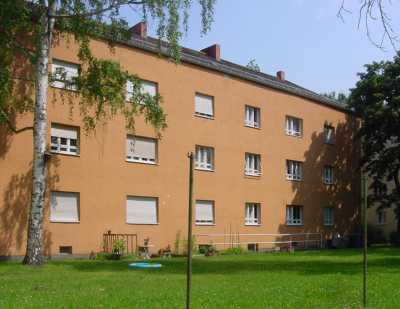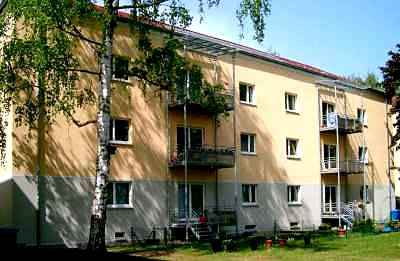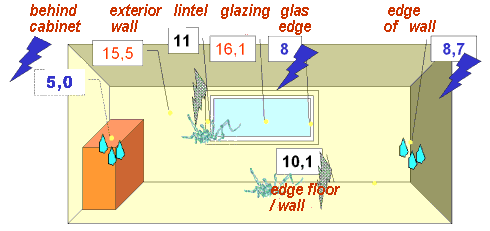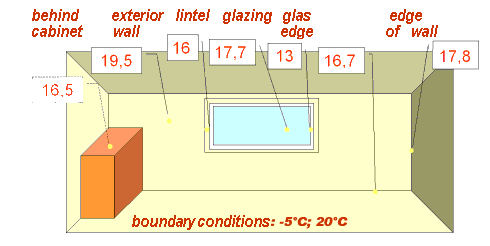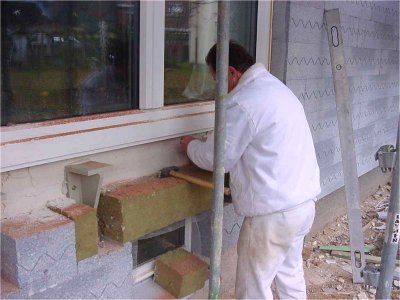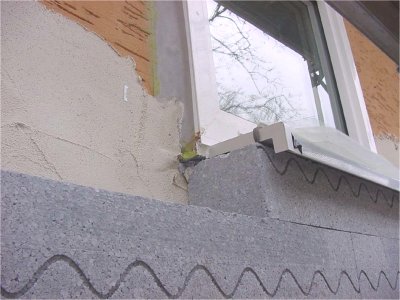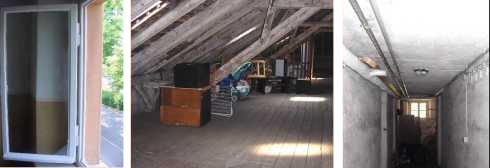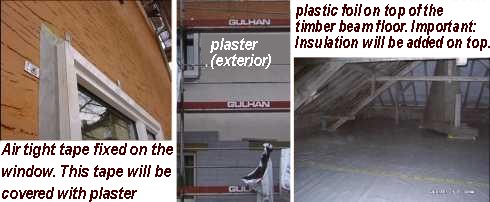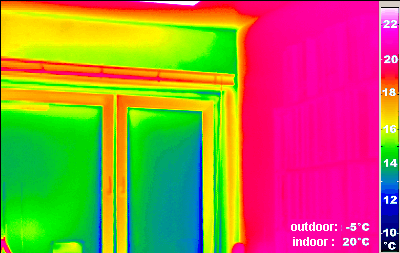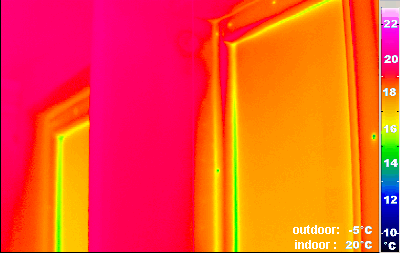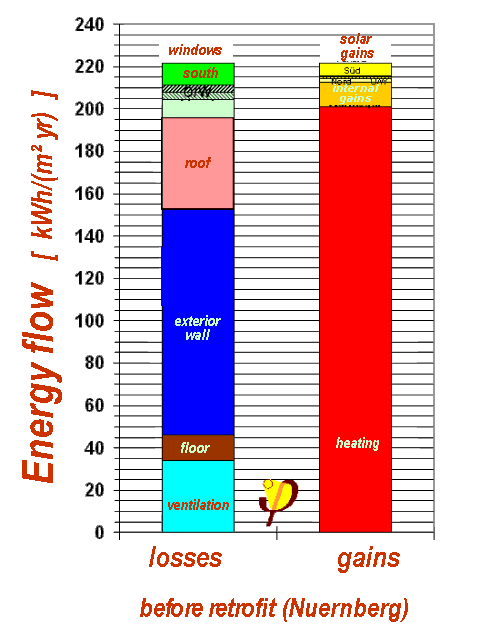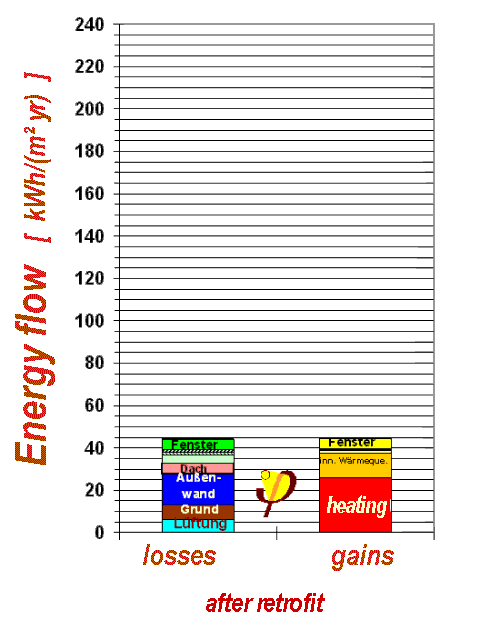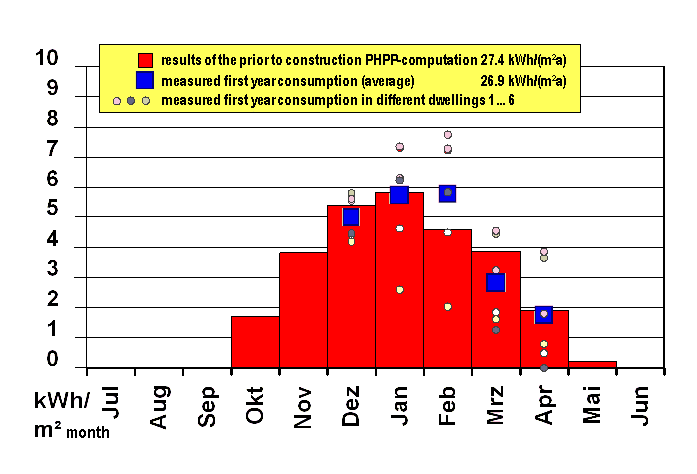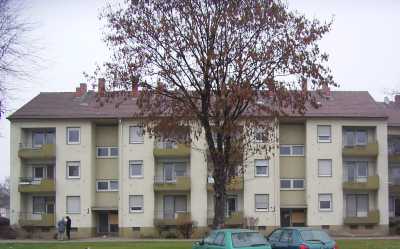| |
Modernization
of Old Buildings: |
|
Rennovated
buildings usually have an existing heat dirtribution system
and there is no reason not to use the very same system after
renovation. With the renovation the heat requirement is
reduced, then the system temperatures can also be reduced.
Therefor, high efficiency boilers and heat pumps can then
be used. Good thermal insulation and high efficency mechanical
equipment go hand in hand. |
||||||
| Old building before upgrades
|
Rennovated building - with Passive House components
|
|||||
| Research
shows that increasing insulation levels minimizes problems
associated with thermal bridges such as condensation. The
following diagrams illustrate this. If the wall is well insulated,
as seen on the right, the moisture problems in the room are
eliminated. You can find additional details on the this project
in the document: "Modernization of Old Buildings" [ AkkP 24
]. |
||||||
Old building - situation at the front without insulation
|
Well insulated (200 mm) building after renovation
|
|||||
Contrary to popular
prejudices, it is beneficial, when rennovating, to make the
building very airtight. Unsealed gaps and
cracks allow water to get into the wall when it condenses
out of the air passing throught the wall. The planning
principles for new buildings can successfully be transferred
to the modernization of old buildings. In implemented renovations,
the attained airtightness has been surprisingly good. Therefore,
we must refer to how important controlled ventilation of dwellings
becomes: "Those who demand airtightness, must also
provide sufficient ventilation." |
||||||
Old building - often extremely leaky
Old wooden windows; Timber beam attic floor; ribbed slab for main floor.
|
Rennovated building with good airtightness
|
|||||
| After a careful thermal bridge free modernization the windows often remain the most significant weak point. It has been shown, however, that high comfort levels and the elimantion of condensation is achieved when the Passive House windows are used and the window installation is done using Passive House methodology.
|
||||||
Old building - old, poorly insulated and leaky windows Old wooden windows; leaky and poorly insulating - replacement is overdue.
Cold
interior surfaces of an old window (here between 12 and 14°C)
lead to wasted energy and make the occupant feel cold through
radiative losses (IR-image: Feist, in the PHI office space) |
Passive house window - the best choice
The new window installed: A
warm window with triple glazing, warm-edge spacers and
a highly insulated frame. This window will be considered to
be high performance for the next 50 years.
In contrast, Passive House windows have high internal surface temperatures: Both for the glazing (here: 17 °C) and at the framework. This creates good comfort for the occupants in the room. (IR-image: Feist, in the Passive House Darmstadt Kranichstein)
|
|||||
| Providing
sufficient fresh air is a main focus in rennovating an old
building. The typically recommened "twice daily intermittant
ventilation" is not sufficient for the removal of room air
pollutants. With highly airtight building envelope, the safeguarding
of the necessary ventilation
of dwellings is an indispensable component of a responsible
renovation. This statement applies to the modernized of old
building even more than with new buildings: Adequate
air exchange must be ensured. Particularly remarkable with the heating energy balance of old buildings are the high losses through the exterior walls (see the portion with the balance in the following diagram on the left side). It is particularly important then, not only from the building design viewpoint, but also from an energy-economic perspective, to improve the thermal resistance in the walls. The often expressed view not to add insulation to the exterior walls of old buildings, is wrong. That the exterior walls must be better insulated comes not only from an energy perspective but also from a in door air quality one (See the paragraph above over mould avoidance by good thermal insulation). During the demonstration
projects in Ludwigshafen and Nuernberg the heating energy
requirement was reduced to under 30 kWh/(m²a). Old buildings
thus experience a factor 8 improvement. Such drastic improvements
were not considered to be realistic until recently, even in
the building industry. The results of measurement from the
demonstration projects, documented in [ AkkP 24 ], show that
there is a strong relationship between values determined through
computer simulation and the measured results. |
||||||
Energy balance of the old building (before) 2)
The high specific
losses through the exterior walls (blue) and the attic cover
(light red) are remarkable. Solar gains play nearly no role,
because the losses are so high. These high losses have to
be balanced by the heating system (red), which amounted to
a an energy consumption of more than 200 kWh/(m²a) (20-litre
house) before the renovation. |
Energy balance after the successful renovation 2)
The energy balance of the renovated building is much better. Due to the good thermal insulation, the losses are diminished to very small values. The values of the Solar and internal Heat gains changed very little, but now they counteract nearly half of the losses. As a result, the heating energy requirement is very small after the renovation: The modeled energy consumption is 27.4 kWh/(m²a) (2,7-Liter-Haus) resulting in energy savings of 87%.
|
|||||
| Because the exemplary renovation at the building Jean Paul place 4, described here, was actually accomplished in Nuernberg with the presented quality, the measured results for heating energy consumption can now be compared with the modeled results. The actual measured heating energy consumption for the first year was 26.9 kWh/(m²a) - which confirms the modeled results. The graph below compares the modeld results with the measured: The consumption measurements documented in this diagram were performed by the Munich Institut FIW. The results of measurement for the whole building are represented as blue squares. The monthly values during the first year after the modernization add up to 26.9 kWh/(m²a), in the second year it was 24 kWh/(m²a). Measured consumption is even smaller than the modeled amount (PHPP computation, as red columns represented). The renovation reduced heating energy consumption in this building by a factor 8: Remaining consumption is extremely small, it amounts to only about 12% of the original value. Note the significant variation between the values of individual dwellings: This is due to different living habits of the inhabitants (e.g. different thermostat settings, having windows open during the winter). Despite this, it can be seen that even then, energy consumption remains low, the largest individual consumption is approximately 40 kWh/(m²a), still more than 80% less the average consumption in the building prior to renovation. You find a discussion about opening windows here: "may one open the windows in a Passive House?" (German)
|
||||||
In the meantime additional examples of renovations using passive house components were implemented. Among them also the following example of a Passive House renovation of the GAG in Ludwigshafen (PHIB: Passive house in the building stock). |
||||||
|
|
|||||
Result
Passive House components are suitable for use in modernization of
existing buildings. These measures reduce the risk of moisture damage,
improve the occupants thermal comfort through higher surface temperatures
and double the energy savings of a typical renovation
Using highly-efficient components in a high-quality modernization
is more attractive because the quality of life for the inhabitants
increases noticeably
On the other hand modernization measures in existing buildings are
a motor for the economic situation. The results show that there is
a dramatic potential for CO2 savings: The CO2 reduction
obtained in the example renovations amounts to over 75%. The efficiency
improvement makes an increased meaningful use of renewable sources
of energy possible. With these measures, implemented today, we can
prevent the most catastrophic consequences of climate change.
1) The principle reads: Constructions must be airtight on the warm side (thus on the interior side of the thermal insulation in cold climates). The construction should be open to vapor diffusion on the cold side. The example project followed these rules: You may find detailed documentation in: [ AkkP 24 ]
2) These energy Balances were determined using the Passive House Planning Package. (PHPP). This tool also allows the energy optimization of old buildings.
The passive house and the modernization with passive house components are not theoretical concepts. Thousands of buildings (examples) are already implemented. The principles represented in the context of this basic information work satisfactorilly in practice.
One can visit passive houses: Once a year there is the day of the passive house. On this day hundreds of passive house inhabitants open their houses to the public, in order to make it possible for those interested to experience what life is like in a Passive House. The day of the Passive House is organized by:
On the IG Passivhaus site, you can find architects in your area with experience in energy-efficient modernizations.
Current results from exemplary modernizations are presented at The Passive House Conference in working groups.
More on the current passive house conference: www.passivhaustagung.de.
[ AkkP 24 ] Passive
House Technologies used in the Modernization of Old Buildings;
proceedings NR. 24 of the working group economical Passive Houses, 1.
Edition, passive house Institut, Darmstadt 2004 (German, see
the publication list, ![]() pdf,
200kB)
pdf,
200kB)
[ AkkP 30 ] Ventilation
for Old Buildings: Solution variants; 1. Edition, Passive
House Institut, Darmstadt 2004 CGerman, see
the publication list, ![]() pdf,
200kB)
pdf,
200kB)
[ AkkP 32 ] Factor
4 also with sensitive old buildings: Passive house components + internal
insulation; 1. Edition, passive house Institut, Darmstadt 2004
(see
the publication list, ![]() pdf,
200kB)
pdf,
200kB)
Find information on the passive house concept here.
Find information on the economics of passive houses here
Contend of all pages
of this site: directory
passive house.
Go
to thepassive house of the institute homepage:![]()
(last
changed: 6.05.2007 / author Dr. Wolfgang Feist; thanks
to David Stecher for proof reading of the 1st edition
© Passive
House Institute;
unchanged copy is permitted, please give reference to this page)
